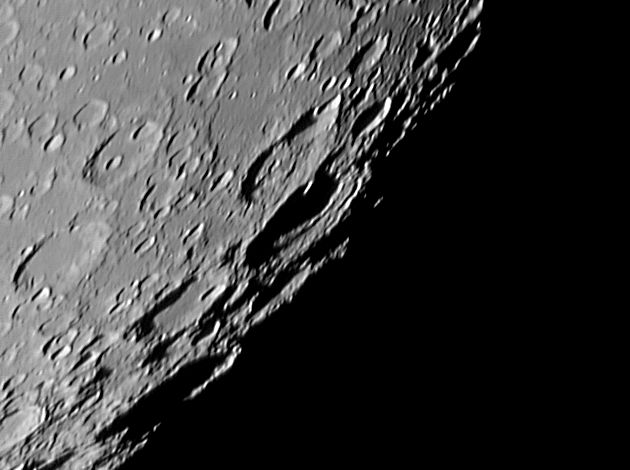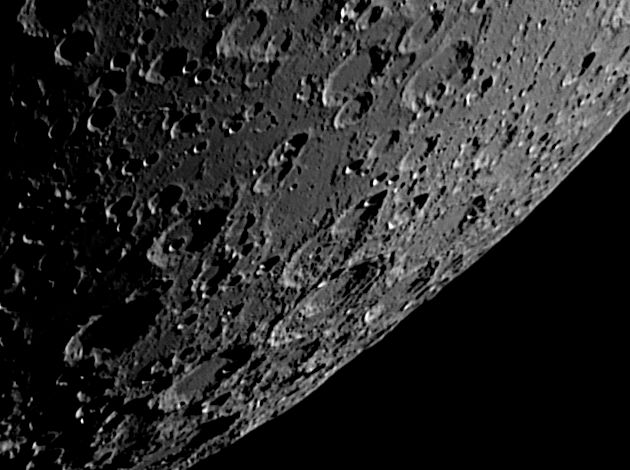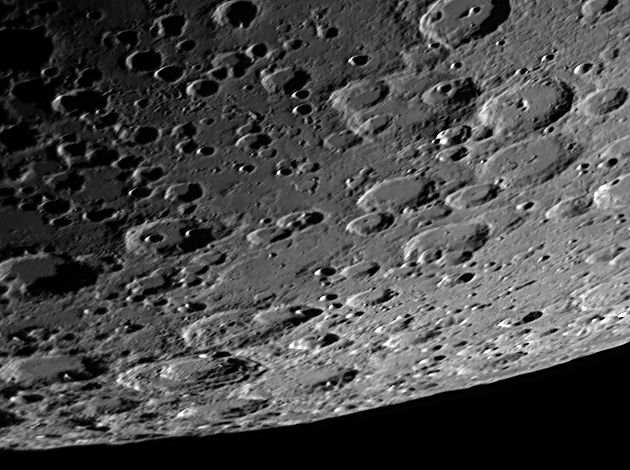

This is an area of the rugged southern highlands and so most (if not all) of the features in these pictures are more than about 4,000 million years old and so date from the earliest days of the formation of the Moon. Boussingault is a fascinating crater, 131 Km in diameter, which contains within it Boussingault A which is 72 Km in diameter, so the pair look rather like a crater with a double wall. Boussingault A is ancient, at around 4,000 million years, but Boussingault must be even older, but cannot be more than about 500 million years older. The complex-looking crater just to the north-west of Boussingault is not a single feature but three overlapping craters known as (from north to south) Boussingault C, B, and E. Move your mouse over the picture to see the names of the various craters.

Boussingault is, unfortunately, not shown well here. The libration was very favourable but the Sun was a little too low in the sky.
The scale markers are very approximately 100 Km north and west and apply at Boussingault, but of course the scale towards the south-east is much smaller due to the perspective as evidenced by the apparent shape of the circular craters. It is amazing, too, how perspective increases the angle between north and west.
The picture was taken with a ToUcam attached to my LX200 on 18th November 2005 at 22:56 UT,
when the Moon was 17.6 days old.
Date and Time: 18th November 2005 22:56 UT
Camera: ToUcam 740K
Telescope: LX200 at prime focus
Capture: K3CCDTools. High gamma, 1/50", 8% gain, 607 frames
Processing: Registax. 83 frames stacked. Wavelets 1 = 10, 2 = 5

Boussingault is shown much more clearly here. The libration was much less favourable, but the light is coming from the other direction and the Sun was higher in the sky, so the craters are shown more clearly.
The picture was taken with a ToUcam attached to my LX200 on 2nd June 2006 at 21:28 UT, when the Moon was 6.4 days old.
The scale markers are approximately 100 Km north and west.
Date and Time: 2nd June 2006 21:28 UT
Camera: ToUcam 740K
Telescope: LX200 at prime focus with an IR-pass filter
Capture: K3CCDTools. Low gamma, 1/33", 37% gain, 614 frames
Processing: Registax. 168 frames stacked. Wavelets 1, 2 = 10, gamma 1.3

Here is the same area shown at a slightly different orientation. I have provided two sets of scale markers: The ones at the bottom apply at Boussingault, and the ones at the top apply at Tannerus.
This picture abuts that of Maurolycus taken the same night. Click on the picture to see a mosaic of the two pictures.
This picture was taken with the DMK 21AF01 attached to my LX200 on 20th February 2010 at 17:55 UT, when the Moon was 6.1 days old.
The scale markers are approximately 100 Km north and west.
Date and Time: 20th February 2010 17:55 UT
Camera: DMK AF2101
Telescope: LX200 at prime focus with an IR-pass filter
Capture: K3CCDTools. Low gamma (10), 1/23", gain 382, 1580 frames
Processing: Registax. 639 frames stacked per alignment point. Wavelets 1 = 10, 2 = 5 Home Back to SE Quadrant